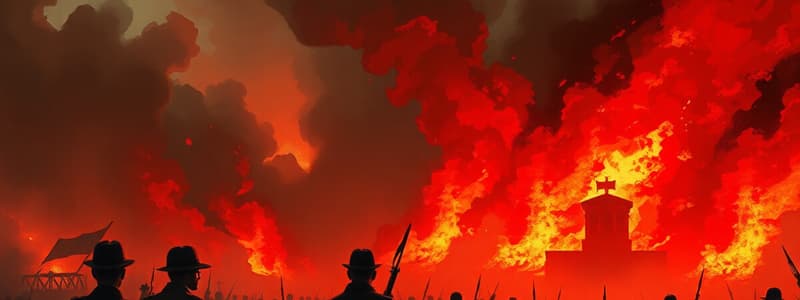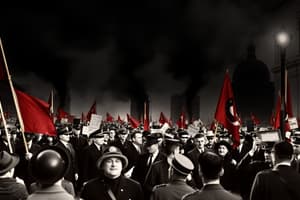Podcast
Questions and Answers
What was the main reason the government was suspicious of labor organizations?
What was the main reason the government was suspicious of labor organizations?
- They wanted to restrict workers' rights.
- They wanted to promote privatization.
- They were in competition with labor leaders.
- They believed they were communist fronts. (correct)
What was a significant outcome of the general strike in Seattle?
What was a significant outcome of the general strike in Seattle?
- It demonstrated the power of coordinated worker actions. (correct)
- It led to increased federal funding for labor.
- It caused the fall of the city’s economy.
- It resulted in immediate labor law reforms.
Who was targeted by one of the bomb blasts on June 2, 1919?
Who was targeted by one of the bomb blasts on June 2, 1919?
- Labor organization leaders
- The ACLU headquarters
- A. Mitchell Palmer (correct)
- J. Edgar Hoover
What organization did A. Mitchell Palmer dispatch agents to raid?
What organization did A. Mitchell Palmer dispatch agents to raid?
What was J. Edgar Hoover's position when he began overseeing the raids?
What was J. Edgar Hoover's position when he began overseeing the raids?
What is the mission of the ACLU?
What is the mission of the ACLU?
What does the resurgence of the KKK in the 1920s signify?
What does the resurgence of the KKK in the 1920s signify?
Civil liberties include which of the following?
Civil liberties include which of the following?
What concern did the government have regarding hyphenated-Americans during the war?
What concern did the government have regarding hyphenated-Americans during the war?
What was the purpose of the Committee on Public Information (CPI)?
What was the purpose of the Committee on Public Information (CPI)?
How did public attitudes toward Germans change during the war?
How did public attitudes toward Germans change during the war?
What did the Espionage Act target?
What did the Espionage Act target?
What did the Sedition Act of 1918 criminalize?
What did the Sedition Act of 1918 criminalize?
What was the public perception of the IWW during this time?
What was the public perception of the IWW during this time?
What happened to Eugene V. Debs as a result of the Espionage Act?
What happened to Eugene V. Debs as a result of the Espionage Act?
What was the fate of Big Bill Haywood after his conviction?
What was the fate of Big Bill Haywood after his conviction?
Flashcards
Hyphenated Americans
Hyphenated Americans
The fear that immigrants wouldn't be loyal to the US during wartime due to ties to their home countries.
Committee on Public Information (CPI)
Committee on Public Information (CPI)
A government agency created to spread propaganda and mobilize support for World War I.
Espionage Act of 1917
Espionage Act of 1917
A law passed to prevent interference with the draft or criticism of the government during World War I.
Sedition Act of 1918
Sedition Act of 1918
Signup and view all the flashcards
Industrial Workers of the World (IWW)
Industrial Workers of the World (IWW)
Signup and view all the flashcards
Big Bill Haywood
Big Bill Haywood
Signup and view all the flashcards
Eugene V. Debs' Imprisonment
Eugene V. Debs' Imprisonment
Signup and view all the flashcards
Propaganda
Propaganda
Signup and view all the flashcards
First Red Scare
First Red Scare
Signup and view all the flashcards
Seattle General Strike
Seattle General Strike
Signup and view all the flashcards
Palmer Raids
Palmer Raids
Signup and view all the flashcards
J. Edgar Hoover
J. Edgar Hoover
Signup and view all the flashcards
ACLU
ACLU
Signup and view all the flashcards
KKK Resurgence
KKK Resurgence
Signup and view all the flashcards
Civil Liberties
Civil Liberties
Signup and view all the flashcards
Study Notes
The First Red Scare and Immigration
- The U.S. government, concerned about loyalty during WWI, established the Committee on Public Information (CPI) to promote pro-war sentiment.
- The CPI engaged in propaganda efforts targeting "hyphenated-Americans" to ensure their allegiance.
- Post-WWI, anti-German sentiment was redirected towards communists, anarchists, and socialists.
- Propaganda campaigns demonized these groups. Examples include renaming food items like sauerkraut to "liberty cabbage" and hamburgers to "liberty sandwiches".
- The Espionage Act of 1917 and Sedition Act of 1918 escalated during WWI, criminalizing criticism of war efforts.
- Eugene Debs, a prominent labor leader, was imprisoned under these acts.
- The Industrial Workers of the World (IWW) was viewed with suspicion due to ties with socialist and anarchist movements.
- Big Bill Haywood, a leader of the IWW, was a target of government surveillance. After being convicted of violating the Espionage Act, he escaped to Russia and remained there.
- Labor organizations in general faced government distrust due to perceived connections with radical groups.
- The Seattle General Strike of 1919, demonstrating worker solidarity, alarmed both the government and businesses. Workers coordinated a strike affecting various fields.
- Anarchist bombings in June 1919 caused widespread fear, targeting a prominent government official, Attorney General A. Mitchell Palmer.
- This led to a crackdown on radical groups, with J. Edgar Hoover, Director of the Radical Division, supervising raids.
- The ACLU, a product of the Red Scare, works to defend civil liberties.
- The rise of the Ku Klux Klan (KKK) in the 1920s broadened its target groups to include Catholics and Jews, along with African Americans, spurred by increased immigration from Europe.
- The Immigration Act of 1924 significantly restricted immigration, favoring those from northern and Western European countries, limiting immigration from other regions.
- The Immigration Act of 1924 had a substantial impact on immigrant populations from Italy and Russia.
Studying That Suits You
Use AI to generate personalized quizzes and flashcards to suit your learning preferences.
Related Documents
Description
Explore the impact of the First Red Scare on U.S. immigration and societal sentiments during and after World War I. Learn about the propaganda efforts by the Committee on Public Information and the criminalization of dissent through the Espionage and Sedition Acts. This quiz delves into the anti-communist fervor and its effect on various immigrant groups in America.




